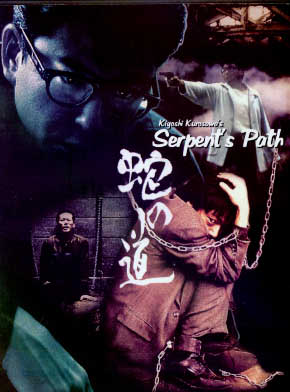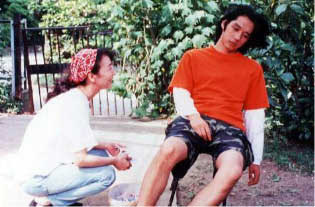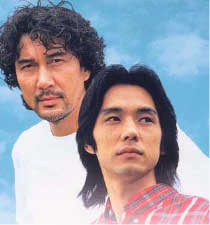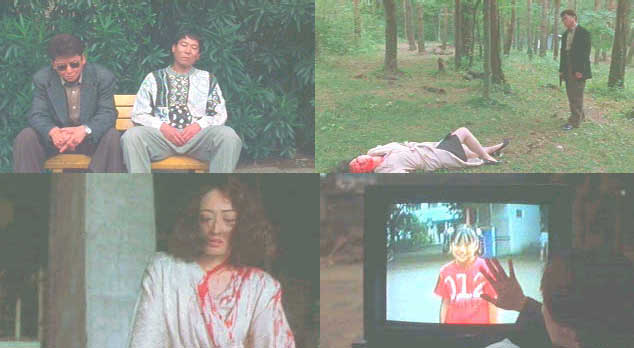

By Michael Wells
Alright, let’s get it out of the way. Kiyoshi Kurosawa is not related to Akira Kurosawa.
When the towering Akira, Japan’s cinematic ambassador to the world for half a century, was gathered to directors’ heaven in 1998, the now 46 year old Kiyoshi was just emerging from journeyman obscurity to international notice. It’s tempting to posit some kind of supernatural transference– not because the younger man’s work resembles that of the older at all. It’s just that that’s the sort of thing that would happen in a Kiyoshi Kurosawa movie. “I can’t shake this creepy feeling,” comments a character in Séance. The understatement could apply to most of the six Kurosawa films showcased recently at The Screening Room in Manhattan. Even those works that don’t fit into the horror genre feel haunted.

Séance (2000), for one, does fit well enough into the horror pigeonhole, the relative accessibility making it a logical series opener. Kurosawa loosely adapts Mark McShane’s 1961 novel Séance on a Wet Afternoon, an impeccably smooth armrest-gripper about a dubious medium and her husband tripped up by their publicity-grubbing kidnap stunt. Kurosawa takes the supernatural from the story’s margins and puts it front and center, complete with ghostly apparitions. To what end he did this is difficult to discern; it hardly changes the substance of a tale about ordinary people overreaching and falling over the edge into their own worst depths. Other plot changes introduce holes and inconsistencies. And leading man Koji Yakusho – deservedly a favorite of the director – just naturally projects a little too much certitude and integrity to be utterly convincing as the man sucked into his spouse’s lunatic plot.

Yet most of these objections only occurred to me in retrospect – after I’d shaken off the film’s clammy seduction. A minimalism pregnant with foreboding (one of Kurosawa’s specialties) refreshes the standard ghost story shudders; horror places a light finger on your shoulder or flits quietly through your peripheral vision. Then again, maybe I was just affected by the resemblance of the female phantoms, with shadowy blanks instead of faces, to one of my more vividly recalled childhood nightmares.

It’s tempting to blame the script hiccups in Séance on its status as a hired gun assignment originally intended for TV broadcast. But the workaholic Kurosawa seems not to mind such unglamorous tasks and has expressed a refreshingly modest belief that any creative work offers potential for honing his craft. Indeed, License to Live (‘99) demonstrates that deeply personal doesn’t always equal compelling. License is a rather too deadpan dramedy about a 24 year old man who wakes up after 10 years in a coma and attempts to reinsert himself into a family and a life that has fallen apart in the meantime. It’s an immediately intriguing premise that yields a few amusing and some affecting bits: “Did I ever really exist?” the hero asks in the movie’s most memorable and oft-quoted line.

Moments like that prevent me from fully disrespecting what I nevertheless consider a buttock-chafing bore. When Kurosawa works in fright movies and crime films, the tension between their traditional luridness and his oblique sensibility creates a fruitful alchemy. In License, though, an already gentle story is practically put into a coma by this same sensibility. I saw it at the ‘99 New York Film Festival and wished then that I’d skipped it, so I took the opportunity to do so the second time around. Given its exalted place among Kurosawa partisans, though, I’m likely to give it a second chance someday.

It’s instructive to see the same filmmaker galvanized by material that in theory is comparatively routine. Eyes of the Spider and The Serpent’s Path (both ‘98) are a pair of linked pieces on crime and revenge, scripted by others (Yoichi Noshiyama and Hiroshi Takahashi) and completed in a month total for release in Japan’s bustling straight-to-video market. The titular animal metaphors are apt. The films are small (less then ninety minutes each) and have a venomous bite. Each story centers around an Everyman who grieves the heinous murder of his young daughter, plots payback and winds up in the middle of yakuza (gangster) intrigue; and each showcases the compact, stonily intense face of B movie icon Sho Aikawa, another Kurosawa favorite.

Spider opens with Aikawa’s Mr. Niijima already holding his suspect captive, and focuses on the aftermath: he stumbles into employment with a pack of comically bumbling, two-bit hitmen. Numbed by grief and unassuaged rage, the salaryman turns out to be the most effective killer of the group. (“Do I seem different to you?” he asks his unsuspecting wife in a moment that pokes at the heart like a pencil-thin switchblade. I was reminded of a newspaper story about laid-off Japanese breadwinners who continue to pretend to their families that they’re going to work everyday.) Poker-faced slapstick keeps intruding into the expected solemnity, as when a doddering yakuza boss drags Niijima to the countryside on fossil-hunting expeditions. It all hardly prepared me for the spooky, poignant impact of Spider’s final shots. I might call it a twist ending if I could make heads or tails of it in a conventional narrative sense. (Comments one viewer, “I don’t think I’ve seen a Kurosawa ending yet that I completely understood.”)

Serpent’s Path isn’t that hard to grasp – it’s the most straightforward of any of the six movies, so I feel vaguely guilty for choosing it as my favorite. It’s a hell of a thriller, though, as icily piercing as a syringe kept in the fridge, though not without its own seizures of absurdist humor. Aikawa once again portrays a joe named Niijima (intelligent viewers disagree about whether it’s the same guy), this time aiding another bereaved father on his own vengeance quest. Together, they brutalize their way through a lengthening list of yakuza thugs in search of the child killer. As one might expect, it culminates in a twist, but far from being a gimmick, the sting in the tail deepens the moral queasiness of the story. They might take different routes, but Spider and Serpent both map the slippery downward path of a man who chooses eye-for-an-eye violence and doesn’t look back until it’s too late.

For pure, unadulterated Kiyoshi, though, fans seem to prefer Charisma and Cure, which display the filmmaker operating at the misty limits of his dreamcode style. These are viewing experiences in which you either surrender to the flow or fight it and drown. Charisma (‘99) leaves behind Kurosawa’s typical, bleak palette of urban/suburban decay when a burnt-out police negotiator (Séance’s Koji Yakusho) wanders into the countryside on a forced vacation. This is the series’ most aesthetically beautiful film, awash in blue sky, honey-golden light through branches and the lacey shadows of leaves. In the middle of this idyllic setting, Yakusho stumbles into a local conflict over a strange tree dubbed “Charisma,” which is either an irreplaceable rarity or a soil-poisoning parasite or both.

The movie refuses, much as its hero does, to commit to any clear viewpoint on the struggle, and barely commits to a story. Kurosawa prefers to generate a bewildering latticework of possible interpretations, like an out-of-control tree sprouting roots in all directions, and he leaves it to us to dig them up. At times it’s a dark parody of fantasies about wounded heroes retreating to Nature to heal. Religious allegory suggests itself, as the Charisma controversy moves beyond science into the seemingly mystical. Although topical agendas aren’t Kurosawa’s thing, environmental metaphors are both an obvious angle and a useful key to penetrating the movie’s fog: simply put, Charisma presents the characters with a choice between the forest and the trees. This in turn suggests an allegory of Kurosawa’s own career, with its back-and-forth tugging between the commonplace and the unique. And then it all goes ka-boom in what appears at first glance to be an out-of-left-field conclusion. Some audience members will put together a coherent picture from the smoking fragments; others, feeling burned already, will want to leave them where they lie. I could hardly call it a fully satisfying experience, but it is a haunting one.

Ditto Cure (‘97), probably the quintessential Kurosawa, taking rock-solid crime and horror conventions and pulverizing them into swirling dust. It opens in true X-Files fashion, with the police baffled by a series of motiveless mutilation killings committed by ordinary citizens. The problems of the detective protagonist (Yakusho again) are hardly over once he collars the culprit: an amnesiac drifter whose influence unleashes others’ homicidal impulses. Occasional passages in Kurosawa’s screenplay give off the musty odor of threadbare cop movie clichés; it’s always a relief, for example, when Yakusho’s exposition-spouting police psychologist sidekick exits. Fortunately, the director’s hypnotic powers rival those of the film’s villain. All his tools come into play: subtly off-kilter framing and counterintuitive editing that unsettle a viewer’s sense of time, geography, cause and effect; the ominous soundtrack of rumbles and droning sounds in place of music; shadowy, ramshackle locations that make the whole film feel set in a ghost town. Even more than usual, Kurosawa demands that the audience read between the lines. I was only able to puzzle out the ending with the help of a knot of people debating it outside the theatre afterwards.

Sounds like something that would make you want to throw popcorn at the screen? I must admit I had to restrain my pitching arm a couple of times. Kurosawa doesn’t always earn the air of portentous mystery in which he drenches his films, and his deliberate frustration of the audience sometimes reaches a point of diminishing returns. But it’s hard to argue with the way his work clung to me in the dark and echoing subway tunnels. I have a premonition: myself, returning to the creations of “the other Kurosawa,” like a sleepwalker under a mesmerist’s compulsion.
Cure is available on R1 DVD from Cowboy
Pictures. For those with a region-free player and cash to burn, Cure,
Charisma
and License to Live are available on Japanese
DVD with English subtitles; log on to AsianDVDGuide.com for more information.
Michael Wells can be contacted here.